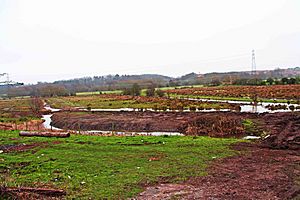Wilden Marsh facts for kids
Quick facts for kids Wilden Marsh |
|
|---|---|

Fields east of Oldington Bridge
|
|
| Lua error in Module:Location_map at line 420: attempt to index field 'wikibase' (a nil value). | |
| Location | Kidderminster |
| Area | 38 hectares (94 acres) |
| Operated by | Worcestershire Wildlife Trust |
| Website | Wilden Marsh |
Wilden Marsh is a cool nature reserve managed by the Worcestershire Wildlife Trust. You can find it in Worcestershire, England, right between the towns of Kidderminster and Stourport-on-Severn. It's super close to the Staffordshire and Worcestershire Canal and sits right next to the River Stour. This special place is even called a Site of Special Scientific Interest because it's so important for nature!
Contents
Wilden Marsh: A Special Nature Spot
Wilden Marsh covers about 38 hectares, which is like 70 football fields! The ground here is made of alluvial soil (silt and sand left by rivers) on top of clay. This mix helps create the marshy conditions that many plants and animals love.
What Makes Wilden Marsh Special?
Wilden Marsh is connected to another nature spot called Spennells Valley nature reserve. They are linked by Hoo Brook, which also has marshy areas and pools.
Why Connected Areas Help Nature
When nature areas are connected, it's like creating highways for wildlife! Animals and plants can move between different places. This helps keep many different kinds of living things healthy, which we call biodiversity. It means there's a wider variety of life in the area.
Protecting the Marsh
Back in the 1970s, the River Stour was dug deeper, and a small dam (weir) was taken out. This made the marsh much drier, which changed the types of plants that could grow there.
How We Help the Marsh Stay Healthy
To fix this, people have put special rock ramps back into the river. They've also worked on the sluices (water gates) and drainage ditches. These changes help bring water back to the marsh. Experts keep watching the marsh to make sure it stays wet enough for all the special plants and animals.
Sometimes, cows are allowed to graze in the marshy fields. This might sound strange, but it helps! The cows eat the tall, tough plants, which stops them from taking over. This allows smaller, more delicate marsh plants to grow.
The reserve also has different kinds of habitats. You can find reed beds, which are like tall grassy areas, and drier fields. There are also small woods filled with alder and willow trees.
Plants and Animals You Might See
Wilden Marsh is home to many interesting plants and animals.
Amazing Plants of Wilden Marsh
Some of the special plants that grow here include marsh cinquefoil, marsh arrow-grass, and marsh pennywort. These plants are adapted to live in wet, marshy conditions.
Wonderful Wildlife of Wilden Marsh
Many different kinds of birds have been seen at Wilden Marsh. You might spot warblers, which are small, active birds, or bright blue kingfishers darting over the water. Woodpeckers are also common, tapping on trees. Sometimes, lucky visitors might even see snipe or water rail, which are shy birds that hide in the marshy plants.

